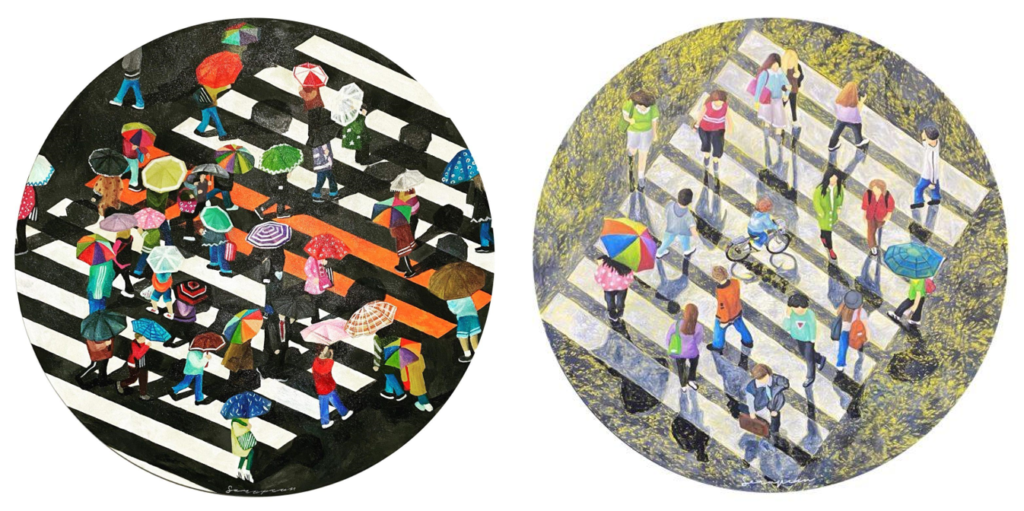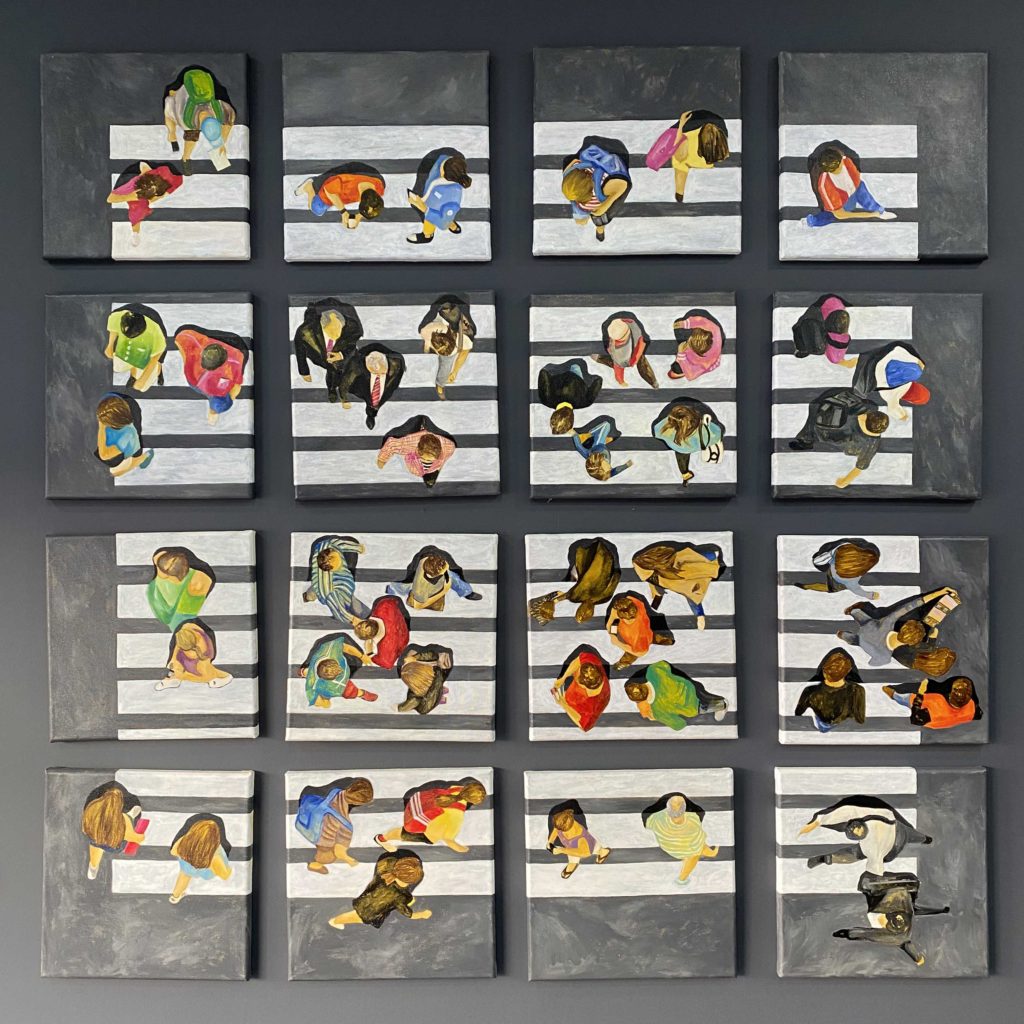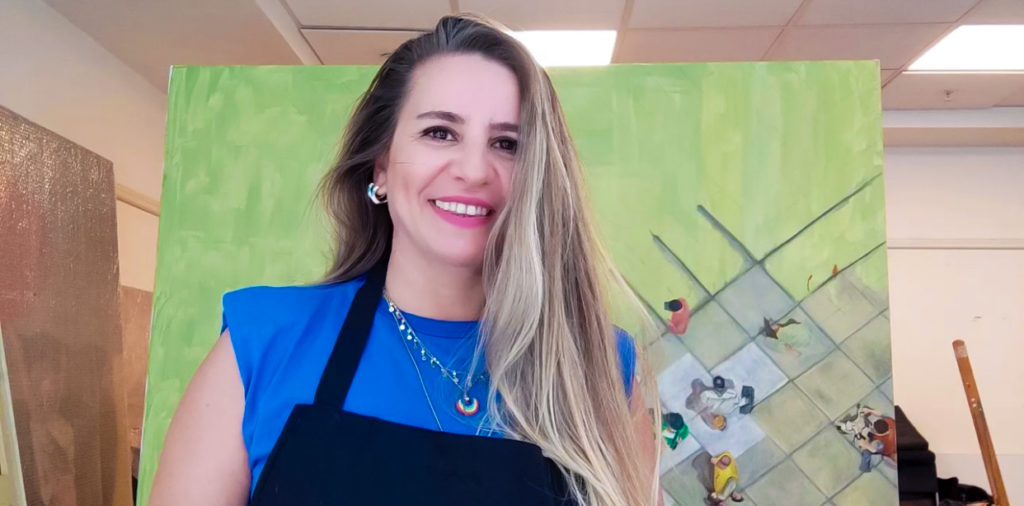Serap Can’s works feature randomly selected crowds from urban life. In her works she combines dynamic scenes placed in a tight order with a vibrant color palette, creating a kind of life map that shows the perspective of the metropolis and the way it exists in the world.
After completing her education at Sakarya University Faculty of Fine Arts, Department of Painting, Serap completed her master’s degree in Plastic Arts and Painting at Yeditepe University Institute of Social Sciences. She currently works as a teacher of arts for children at a private institution in Istanbul.
How did your relationship with art begin?
I have been painting since I was a child. My father used to draw amazing pictures and I used to try to copy them with admiration. I had a notebook where I drew the emblems of every brand I saw back then and I always had it with me. I also thought that everyone could paint well, they just might not have chosen to do it. I can say it took me a long time to understand myself. I started to draw professionally during my university years. While studying at a different university in a department that I was not very happy with, I started to develop an interest in painting professionally and I wanted to test myself by taking the exams for the faculty of fine arts. When I passed the exam, I left school and continued to study fine arts. My passionate relationship with art started at this point.
You provide art education for children in a private institution. How do you value this experience in terms of your art?
The best way to teach someone something is to teach it to a child. It is an incredible joy to share my art knowledge and experience with children. I can say that they teach me to look at art and even life in a simpler, more straightforward and positive way. I have a lot of dialog with them about my own work as well. I value their questions and ideas very much and sometimes they guide my work.
We name some of my works together. For example: Umbrella Party 🙂

What are the psychological and environmental factors that nourish you during the art production process? How do your sources of inspiration find a place in your art and trigger your production?
As someone who grew up in a small town, the chaos and hustle and bustle of the metropolis I settled in made me psychologically exhausted. The noise and chaos of the city affected in my work as a reflection of the process from my early years, when I could not feel a sense of belonging, to my recent periods of integration.
Considering your works so far, it is possible to say that you produce works that establish a dialog with each other and have a common form of expression? When approached iconologically, how would you briefly describe your art?
The only thing the crowd in my work does is walk. One is coming from one job and going to another, one is out shopping with her child, one has a laptop in her hand, another has a phone, another is returning from the market with shopping bags, etc. They are all in an imaginary square that I built, randomly placed left and right. They pass by.
As an artist with an academic identity, where would you position your own productions in the whole history of art?
At some point, I can say that my works contain both the critical point of view and the bright colors of Pop Art.

As an artist living and producing in the metropolis, you include crowded human landscapes in your works. How did this situation develop; what are its sources?
Actually, in the works I produce, I say that human nature is not suitable for living in crowds in city life. We try to realize our dreams by living in the masses, surrounded by many strangers. I am deeply moved by the crowded human landscapes trying to realize their dreams, as I am a part of the crowd.
Your art is dominated by dynamism and bright colors. What are your expectations about the impact of this on the viewer? Can you share your impressions about the communication between your works and the audience?
Colors have a symbolic communication purpose. I prefer more color and fun in my daily life, maybe it is a result of working with children.
You use photographs in your work to transfer images from the real world into your art. How would you interpret the relationship between your productions and photographs?
I have a very close relationship with my photographs 🙂 The creation process is also very fun. In general, all of my works are from the top perspective. Someone walking downstairs in the mall, someone walking in the park or someone coming out of the market with a bag in their hand meet in the same imaginary square. I create hundreds of compositions in this way, just like the hundreds of compositions we create in real life without realizing it.
In 2015 you received the “Young Artist of the Year 2015” award. How did this award affect your career?
Receiving the award motivated me incredibly. It was a time in my life that gave me excitement and self-confidence. The rest comes anyway.

Are there any books, movies, or artists that have left a mark on your artistic production, that you are inspired by?
Art history as a whole influences me a lot. Apart from that, I’ve always admired Paul Klee and I loved his book “Diaries”. I think I’m also influenced by his colorful works. I follow a lot of artists working in Pop Art and illustration; it’s hard to name just a few.
What kind of a future do you imagine for your career? What are your future plans?
I can say that I am in a flow where everything I do excites me a lot. I wish that this excitement will never pass, and when it does, it will take me to every point I dream of.
What do you think about your works meeting art lovers with Art50.net and online art platforms?
It is inevitable in the digital world, people can access art at any moment. Art50.net is the best online art platform I have heard about and seen. I am happy that we are working together.
You can see Serap Can’s recent works at the exhibition Rhythmic Transitions at Swissôtel The Bosphorus, Istanbul, 7 days a week until January 31, 2024.
Click for the exhibition catalog and prices.

 Türkçe
Türkçe